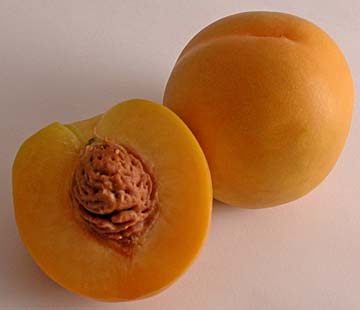
Mixed marriages
Cross-pollination produces fruit
"children" that aren't quite
the same as mom and dad
Don't call these fruits mutants, clones, Franken-fruits or -- heaven forbid -- genetically modified. Hybrid is more acceptable. The industry prefers that you think of them as, well, exotic.
These stone fruits carry such unglamorous names as pluot and peacharine, designed to emphasize their mixed parentage (a plum and an apricot; a peach and nectarine). They are the products of cross-pollination, sometimes called inter-species pollination.
Their season is now, and it's a short one. Most varieties are around for just two or three weeks. Those pictured on this page will be in supermarkets only a few more days, although other hybrids -- particularly the many types of pluots -- will be passing in and out through August.
Mike Watts, director of specialty fruits for Kingsburg Apple, says it takes about five years to bring a new fruit to market. Kingsburg, located near Fresno, Calif., is a major producer of hybrids.
The process: A plant -- a plum tree, for example -- is cross-pollinated by hand with pollen from, say, an apricot tree. The seeds that result are planted. Trees grow from those seeds and bear fruit after a period of years. Those second-generation fruit are the "children," as Watts puts it, and there could be hundreds, all different in some way. The fruits of the experiment, so to speak.
"In one crossing we might get 1,000 different things ... after we evaluate them we might get one or two or nothing," he says. By which he means new hybrids worthy of the market. The most promising fruit are then propagated from cuttings.
Kingsburg has 30 to 35 hybrid varieties and releases a couple of new ones every year, Watts says. The aim is fruit that is consistently sweet. "We're constantly looking for different colors, different flavors."
MANGO NECTARINE
Despite its name, this fruit is a cross between two varieties of pale nectarine, no mango involved. It is named for its texture and flavor, which the producer, Ito Packing, says blends both fruits. Coming into season in a few weeks is a honeydew nectarine, another nectarine cross that is slightly green with a faint taste of melon.
PEACH + NECTARINE = PEACHARINE
A peacharine is 50 percent peach, 50 percent nectarine. It is darker outside than a typical peach, but pale inside, and has very little fuzz. The flavor is a blend of the two fruits and usually quite sweet, although the early season fruit is tart.
PLUM + APRICOT = PLUOT
A pluot (PLU-ott) is 75 percent plum, 25 percent apricot. When the percentages are reversed, that's an aprium. The variety shown, Flavor Supreme, is light red, with a pinkish flesh inside. Other pluots may be purple, yellow or speckled and go by names such as Dinosaur Egg. Pluots tend to be sweeter than plums, without so much tartness right under the skin.
NECTARINE + PLUM + APRICOT = NECTACOTUM
A nectacotum (neck-tah-cah-tum) is one-third each nectarine, plum and apricot. The hybrid, now in its third season, is large, dark and smooth-skinned, with dark, plum-like flesh.
Fruit courtesy Armstrong Produce
Click for online
calendars and events.





